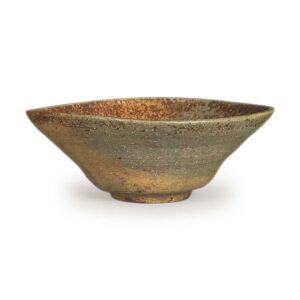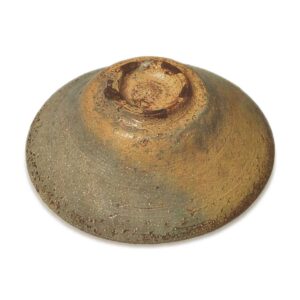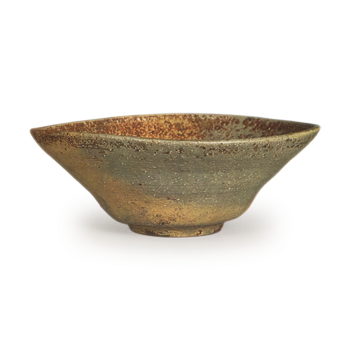

Name: Kawamura Soba
Height: 5.7-6.4cm
Diameter: 16.8-17.0cm
Height of foot ring: 5.4cm
Height of body: 0.5cm
The light blue-gray and loquat-colored grounds are arranged diagonally on one side of the bowl, and it is said that this name was given to the bowl because it resembles the moon hanging in the sky at dawn. It is also called Kawamura Soba because it was owned by Kawamura Usou, one of the Ten Great Masters of Edo.
Most soba bowls are flat and shallow, with a rim that curves inwards, and bowls with a tight foot are highly prized. Zangetsu is known as a representative masterpiece of soba, and it fulfills these conditions. It is thinner than Ido and thicker than Totoya. The clay is characterized by its white, sandy texture, and it is also commonly referred to as soba or soba-kasu.
One theory is that the name soba comes from the similarity of the greenish-grey color of the clay to that of soba noodles. Another theory is that, although it is not a well, it can be placed near a well, and so it is called soba.
In the book “Kora Tea Bowls and Seto Tea Caddies” by Yusaku Imaizumi and Hikotsugu Komori, it says, “Since ancient times, it has been customary to write it as soba glaze, but its original meaning is that it is by the side of a well, that is, by the side, by the side, and although it is not a well, it means that it is something that is close to the side of a well. It says.
Regarding soba kasu, the “Meisaku Mekibunsho” says
Soba kasu: This tea bowl has the appearance of a blue well, and there are many precious items among the medicines that resemble fish shops, and there is something like soba glaze, so it is a rare item, but it is a different item from the fish shop and the well.
In the “Tea Bowl Appraiser’s Handbook”, it is written
It is made like a medicine made from buckwheat lees and a medicine made from totoya, and it is rare to make it into a cedar shape or a medicine made from totoya, and it is mostly made into a blue medicine, and there is a pattern on the inside of this medicine that looks like buckwheat husks, so it is called “soba-yō”, and it is thin and the clay is not visible.
The origin of the name is understood to be that the white sand on the surface of the clay is similar to soba glaze.
Zangetsu is considered to be the best bowl of soba, and the clay is a rough clay with a slight iron content, with white sand on the surface. A thin, transparent glaze is applied to the entire inside and outside of the bowl. The firing was slightly reductive, and most of the piece is a light blue-gray color, but the parts that were in the shadow of the neighboring vessel and did not receive any fire have oxidized and turned a loquat color. This is what is commonly referred to as “katamigawari” (one side of the piece is different from the other), but the blue-gray ground and the loquat-colored parts intersect like a patch of clouds, creating a beautiful scene. The inside is also a katamigawari, and there are five eyes in the circular area that is called the mirror, which is slightly lower in the center. There are also five eyes on the foot ring, and the bottom is carved in a spiral shape, with a helmet standing in the center.
The most attractive feature of the remaining moon is the color of the half-turned rim, and the mouth shape, which is slightly cupped, and the plumpness of the waist also have a certain charm. The fact that there are no loose threads or cracks in the glaze is probably due to the fact that the clay is different from that used for the well-known Ido ware, and is more robust, but it is unusual for a tea bowl to have survived for so long.
It was owned by Kawamura Uso, one of the Ten Great Masters of Edo, and was later entrusted to the Matsuura family as a pledge by his son Den’ei, but was acquired by Maekoshi Kyohei at the beginning of the Taisho era. Maekoshi also owned a tea bowl by Tamagawa and another by Soba, and was nicknamed Soba Daimyo (Soba Millionaire) because of this.



